Fifteen years after winning her first surfung world title, in 2022 STEPHANIE GILMORE won her eighth, eclipsing Layne Beachley as the greatest of all time. And she’s not done yet…
Sometimes – too often, in fact – bad things happen to good people for no discernible reason. Having secured her fourth consecutive world title in Hawaii early in December 2010, Stephanie Gilmore had flown home for Christmas to spend it with family and friends. The day after Boxing Day she had been visiting friends nearby and might have walked had not the rain come in that afternoon, so she drove. After dinner she returned to her Coolangatta apartment, parked her car in the ground-floor lot and began walking toward the stairs. Journalist Sean Doherty takes up the story:
She sensed she wasn’t alone. From the shadows a figure ran at her and struck her with what turned out to be a metal bar. She turned as he swung again, blocking the next strike with her left arm. She screamed and the guy took off on a pushbike. The attacker would turn out to be a homeless guy, a schizophrenic who’d never met Steph. He didn’t even know Steph was Steph. It was shitty luck sent from the wider cosmos.
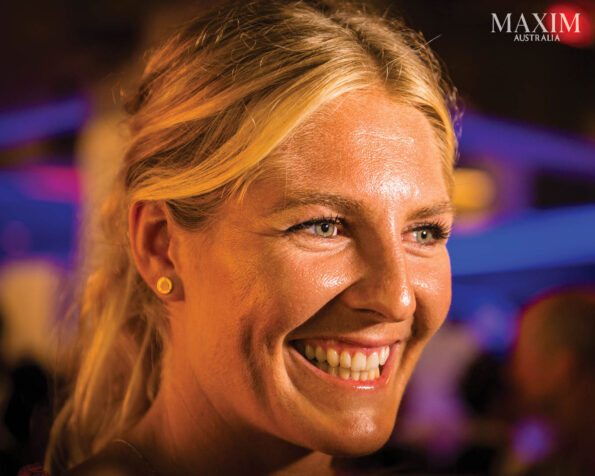
Shielding the second blow earned Steph a broken wrist and she had scalp wounds that required stitches, relatively minor injuries considering what might have been, and she was back in the water in a couple of weeks. The psychological wounds took longer to heal. Six months after the attack Doherty was with Steph and a group of friends, including her surfboard shaper Darren Handley and legendary shaper Simon Anderson, on a Mentawai Islands surf charter. He later wrote:
No one on board was sure exactly how Steph was coping. Nobody broached the subject of ‘the night’. She offered the story after dinner one evening, unprompted. She recounted the details slowly, deliberately. She asked questions of the night, questions of the days after, questions to herself. It was clearly still lurking there, and she was obviously still processing large parts of it. For someone of Steph’s sunny disposition and good fortune, these were uncharted waters.
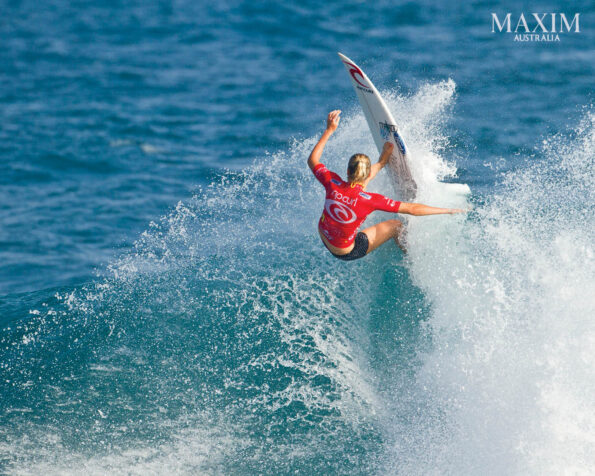
That’s it, right there. Steph had become the golden girl of world surfing almost overnight, winning the world title in her rookie year on tour and going on to make it four successive titles, but what had endeared her to the Australian public even more than her incredible ability and natural flowing style was her ‘sunny disposition’. She was ‘Happy’ Gilmore, almost never seen without a broad smile on her face, bending down her lithe, willowy frame to sign autographs for legions of tiny fans as she made her way up from the surf after a heat, never flustered and never boastful in her media appearances but making her important points – often about equal prize money for women – concisely and authoritatively. In surfing, in most sports, ambassadors don’t come any better.
Then some deranged man attacked her with an iron bar. It was unfathomable.
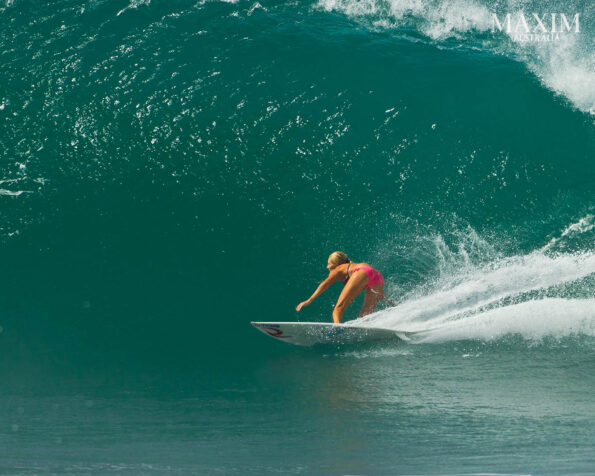
A personal aside: in early September 2010, not quite three months before the attack, I was way back in the economy check in queue for the Virgin flight to Los Angeles when I noticed Steph – yes, the economy line even with three world titles, soon to be four – further towards the front standing tall in a sea of people. She was somewhat preoccupied with texting but rose to the occasion with every request for an autograph or selfie. She didn’t know me well but waved enthusiastically when she spied me. I noted that she never let a fan down throughout her extended wait; in her entire career she rarely has.
Born Stephanie Louise Gilmore in 1988 in what was then the sleepy fishing town of Kingscliff, New South Wales, just over the border and 20 minutes down the highway from the Snapper Rocks Superbank, to parents she has described as ‘a little bit hippie’, Steph grew up on the beach and was riding a bodyboard as well as most of the boys at the age of nine. A year later she had progressed to a surfboard. The youngest of three girls, she was as she told writer Tim Baker ‘a tomboy, the son they never had’. Always happy to get a laugh at her own expense, Steph told another interviewer: “I didn’t shave my legs until I was, like, 16.”
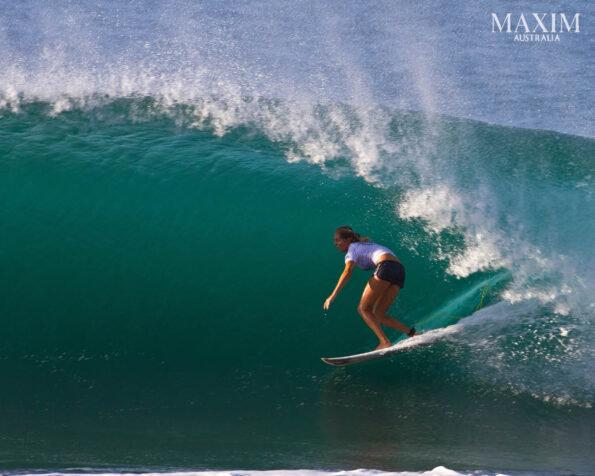
Jeff and Tracy Gilmore were both surf people, Jeff a passionately committed surfer of whom Steph told Vogue Australia: “Seeing my dad be so passionate about it, that is what really ingrained in me how special surfing is, and that is what made me fall in love with it.”
Obviously, Mum and Dad were going to do nothing to dissuade her from surfing, driving her up the coast to Snapper Rocks before or after school. There she fell under the spell of the Coolie Kids Mick Fanning, Joel Parkinson and Dean Morrison, the kings of the superbank. Steph watched and learned. She joined the Snapper Rocks Surfriders Club and was soon at ease competing and free surfing in the perfect sand cylinders of the Gold Coast points.
Gilmore had begun making waves long before she turned pro, winning the New South Wales junior title in 2003 and really turning up the heat the next year when aged 16, winning the Australian junior title and the International Surfing Association world juniors in Tahiti. Still at school, she was now on the world stage. At the end of 2004 Rip Curl, always quick to spot emerging talent, signed her to a lucrative five-year sponsorship deal. valued at more than $1,000,000 subject to her turning pro and qualifying for the world tour.
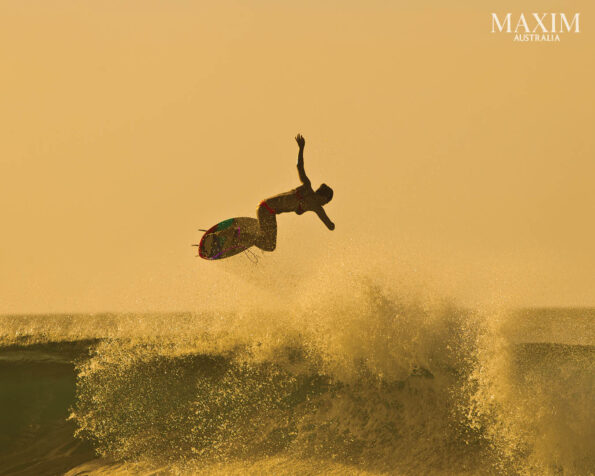
Soon after signing the deal, she was offered a wildcard entry into the Roxy Pro at her home break of Snapper Rocks. She approached it with the confidence of a 17 year old with nothing to lose, beat superstar multiple world champion Layne Beachley by a micro point in the semi-finals in perfect surf then crushed Hawaiian Megan Abubo in the final with a 9.33 winning ride to take the $20,000 prize money. There was already a buzz about Happy Gilmore, but after the Roxy win against the best surfers in the world it became a roar. Not only did Steph have the flowing style and natural ability of a born champion, she had a wonderfully exuberant spirit and sense of fun. Right from the start she was a marketing dream. “‘Million-dollar baby’ Stephanie Gilmore is taking aim at a trailblazing route to surfing stardom,” The Sydney Morning Herald noted in a rather mixed-up article later that year.
Just two weeks after fellow Snapper Rocks surfer Chelsea Georgeson won the women’s world title, recent year 12 graduate Gilmore is boldly hoping to do the same one day, and perhaps surpass Layne Beachley’s record six titles. ‘To be successful and make enough money to be set-up in my life – and maybe a world title [win] or seven along the way,’ Gilmore declares about her career ambition. Cocky perhaps, but when you see what this northern NSW teenager has done in 2005 you won’t think so.
More prescient than cocky, with Gilmore going on to do just that. She had certainly had an extraordinary year, right down to sitting for her final exams at the Australian consulate in Los Angeles en-route to the World Surfing Games.
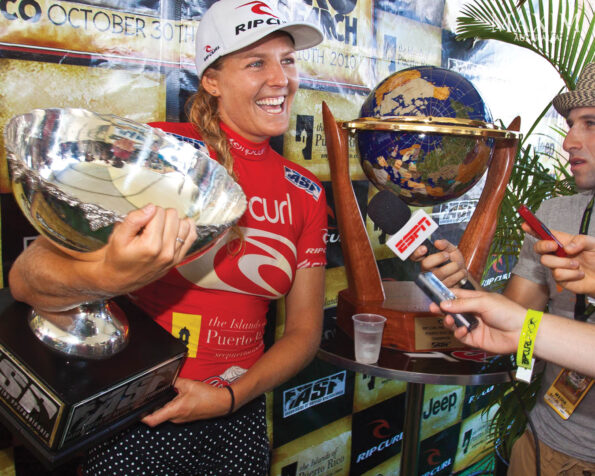
With school behind her, Steph hit the road on the qualifying series in 2006 and was sitting pretty for world-tour qualification at number two in the rankings when she was given another wildcard, this time for the Havaianas Beachley Classic at Manly. Again, she had nothing to lose and surfed methodically through the rounds until meeting Beachley in the final. Layne, surfing at her home beach in the contest she had started, had racked up a nine in her semi-final to defeat reigning world champion Chelsea Georgeson. Having been beaten by the upstart Gilmore grom in the Roxy Pro the year before, she had her winner’s face on this time.
However, it was not to be. Steph got in early with two good rides and Beachley was never in the lead. It was an emphatic victory and Gilmore, who had made the record books in 2005 as the youngest woman to have won an Association of Surfing Professionals world tour event, did so again, this time as the first woman to have won two events as a wildcard.
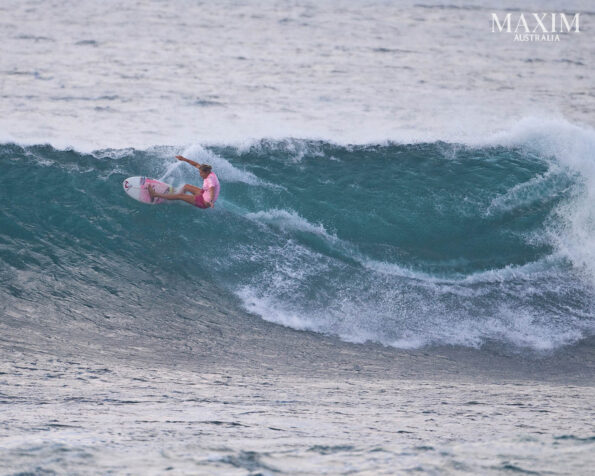
As a tour rookie in 2007 Gilmore made it look too easy, cruising to her first world title by winning four of eight events, including another Beachley Classic and the Rip Curl Pro at Bells Beach. This cemented her popularity with the Australian public and delighted her major sponsor, even as they realised the teenager was swiftly moving towards her bonused million-dollar promise. Steph had gone to the top of the rankings after winning at Bells early in the season but then faltered slightly at the end, taking it to the early rounds of the final event at Honolua Bay before the title was hers. The bay became a happy hunting ground for her over the years. In yet another entry in the record books, Gilmore became the first rookie – man or woman – to win the championship tour.
Defending her title in 2008, Steph notched up five wins from seven events, including both of the Hawaiian events. In 2009 things were a little tighter, with only one victory in the Roxy Pro at Snapper Rocks when the tour went into its final leg in Hawaii. She had a string of second placings to keep her in contention, but at the Gidget Pro Sunset Beach another five surfers also had a shot at the title. While Steph calmly navigated her way to the semis the other contenders were eliminated one by one, leaving her to surf her favoured Honolua Bay in the last event with no real pressure. She won it, of course.
Gilmore’s fourth title campaign got off to a flyer with wins on the Gold Coast and at Bells, and she secured it at the Rip Curl Search event in Puerto Rico in early November 2010. Unfortunately, her celebrations were cut short when word of the tragic death of three-time world champion Andy Irons reached the pro camp just hours later. Irons had mysteriously withdrawn from the Puerto Rico event during the early men’s rounds and was reportedly on his way back to Hawaii. He only got as far as Dallas, where he was found dead in an airport hotel room. The shadow of Irons’s death at just 32 after years of reported drug abuse hung over the final leg of the tour in Hawaii, but Steph managed to stay positive by playing a guitar and shooting videos when not in the surf.
Then she flew home for Christmas and her own nightmare.
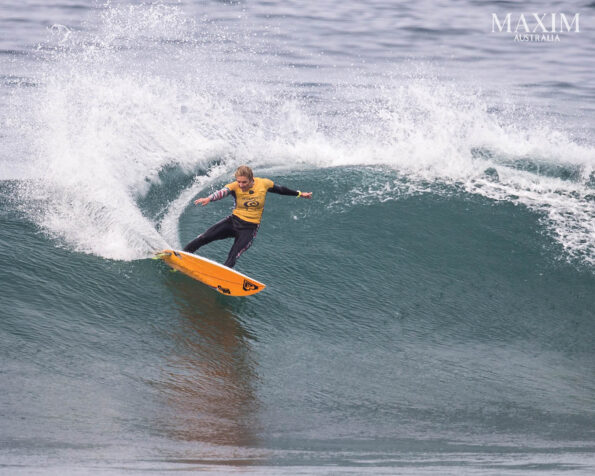
Although her physical wounds healed within a couple of weeks of the December 2010 attack, no one then knew the extent of the trauma she had suffered. It therefore came as a shock to the surfing world when Gilmore emerged on 5 January 2011, all smiles and vivacity, to announce that she had signed a $5,000,000, five-year deal to become the global brand ambassador for Quiksilver Women’s, making her surfing’s first million-dollar female pro. In surfing’s small world changing camps to join a rival is never easy, but Steph made it look so.
“In my eyes,” she told a reporter at the announcement press conference, “the best female surfer is someone who pulls into big barrels and can take getting scraped on the reef but can then turn around and be graceful and stylish in beautiful waves in the most feminine way possible. That’s what I’m trying to achieve.” Meanwhile, a new year had begun, and she had world title number five in her sights.
Steph never quite found her rhythm in 2011 and finished third in a year that established the career of 19-year-old Carissa Moore, the Hawaiian former prodigy who won her first championship title as easily as Steph had done. Layne Beachley, whose own record run of titles was stopped by Gilmore in 2007, told Surfer magazine that “It was only a matter of time before the girls realised that they have the ability to not only beat Steph but to challenge her for a world title.” Maybe so, but don’t poke the bear no matter how happy it looks. Gilmore bounced back in 2012, winning events on the Gold Coast, New Zealand and France to secure her fifth world title before the last contest of the year was held.
If 2011 had been a tough year overcoming trauma, albeit slightly softened by the million a year dropping into her account, 2013 was Gilmore’s annus horribilis. Plagued by recurring injuries, she failed to win an event throughout the season in her worst showing as a pro and finished fifth in the rankings.
She also had to contend, for the first time in her career, with a negative media backlash. to a promotional video she did for the Roxy Pro Biarritz that showed her not surfing but getting out of bed and putting on a negligee to some chill beats. It was sexy in a sweet way but by no means offensive. Not having seen this coming, Roxy ran for cover while Steph left it to dad Jeff to explain that if it got more people interested in women’s surfing then it was a good thing. Strangely, the critics of the Roxy promo had been silent in 2011 when Gilmore posed for the cover of the body issue of ESPN magazine, possibly because Kelly Slater had done the same the previous year.
In 2014 Gilmore won three events for the season – on the Gold Coast, where she sat in with Jimmy Buffet for an impromptu concert on a lay day at Snapper, at Trestles and Cascais, Portugal – taking it down to the last contest of the year, the Target Maui Pro Women’s at Honolua Bay, where her fifth-place finish was just enough to earn her a sixth world title. Commentator Chris Cote wrote of the drama of that day: “In the dying minutes of the final heat of the Maui Pro, Stephanie Gilmore held her breath while Carissa Moore surfed an incredible heat, knocking Tyler Wright out of world title contention, and cementing Gilmore’s name in the annals of surf history by giving her a sixth world title.”
Then came the dog days, when it appeared that the world title game of pass the parcel between Steph and Carissa Moore had ended. Beset by injuries again, Steph didn’t win an event in 2015 (finishing 12th) or 2016 (sixth), but the numbers were at least heading north again. After winning her two home events at Snapper Rocks and Honolua Bay to finish second in 2017, Gilmore felt renewed and buoyed to go after her next target: to catch up to Layne again.
In 2018 she won at Bells Beach and in Rio, and it was enough to give her a seventh world title. The remarkable rivalry between Australia’s two record-breaking surf champions entered its final phase, with Beachley retired and powerless to improve her title count and Gilmore, then aged 30, finding it harder every year to keep up with She also had to contend, for the first time in her career, with a negative media backlash. Which is not to say she was about to throw the towel in: far from it.
In the 10-event 2019 season she won in Bali and at Honolua Bay to finish in fourth place, the highest-ranked Australian on the women’s tour, when along came the COVID-19 intervention, which cancelled the tour in 2020. In the abbreviated, on-and-off 2021 tour Steph finished second at Margaret River and won the final event in Mexico to finish fifth overall. She also won selection to represent her country at that year’s delayed Tokyo Olympics but was eliminated early and had to simply cheer on teammate Owen Wright to a bronze medal, while Carissa Moore took the women’s gold.
If ever a season could be considered career-defining, Stephanie Gilmore’s 2022 would be it. No matter how much longer she stays on the pro tour, the highs, the lows, the sheer drama of it are unlikely to be surpassed.
To kick it off, a positive COVID-19 test just before the historic return of the women’s event to the Pipeline saw her eliminated from the contest with minimum points when it began the day before her COVID protocol of seven days isolation finished. It was a crushing blow, and after a moderate showing at the next event at Sunset Beach, she had to “crawl my way back into the cut”, meaning the ruthless mid-season culling of almost half the field. But Steph fired back with third placings in Portugal and at Jeffrey’s Bay, and a victory in El Savador enabled her to scrape into the last position in the final five.
The win against California’s Lakey Peterson in tricky conditions in El Salvador was a classic Gilmore buzzer beater. With 11 minutes remaining in the 40-minute final she had 1.03 points against her name to Peterson’s 9.67. With even modest scores hard to come by, Steph found a 7.33 and backed it up ahead of the buzzer with a 5.67 to claim the victory. She said later: “I would love to win another world title, but it’s still a long road.”
That road ended across the railroad tracks at Lower Trestles, California on 8 September 2022. In the second year of the WSL’s ‘final five’ knockout format, Steph was at very long odds to take an historic eighth world title, having to beat everyone else in the five by surfing a minimum of five heats in one gruelling day. In conditions that suited her style of surfing, she still looked nervous and off her rhythm in the first heat against Costa Rica’s Brisa Hennessy, but managed a comeback with a combination of good scores.
From this point on there was no stopping Gilmore. Growing in confidence, she dispatched Brazil’s Tatiana Weston-Webb and France’s Johanne Defay before meeting the favourite, world number one and reigning 2021 champion, Hawaii’s Carissa Moore, in the best-of-three-sets grand final. Despite the fact that she had already surfed three 35-minute heats, Gilmore looked energetic and in career-best form. She crushed the Hawaiian in straight sets.
As the final hooter announced that with her eighth title she had officially pulled ahead of Layne Beachley as the greatest female surfer of all time, Steph paddled over to the WSL water reporter, grabbed his microphone and in typical Aussie fashion, let out a roaring crow call to share her joy with viewers around the world. Despite a magnitude of competing interests in her life, Happy Gilmore’s sponsors have always loved her. A decade since signing her first million-dollar a year contract with Roxy, she remains the leading brand ambassador. And in late 2018 she also signed a long-term deal to become the global face of Audi, the German car brand that best fit her growing eco-awareness. Her first public appearance for the brand was at the San Francisco launch of Audi’s E-Tron electric vehicle.
Gilmore had also used her international profile to advocate for ocean conservation for some years, but in 2018 she added pay parity for women’s pro surfers to her list of causes. In September of that year the world’s two highest profile surfers, Kelly Slater and Stephanie Gilmore, released a joint statement in support of the World Surf League’s groundbreaking announcement of equal prize money for women and men on the professional circuit.
ABOUT THE AUTHOR
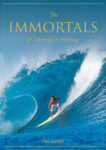
PHIL JARRATT is a journalist, author, publisher and filmmaker with more than 50 years’ experience in Australian and international media. He is a former editor of Tracks, associate editor of Surfer and editor/publisher of Australian Surfers Journal. He’s also worked inside the executive ranks of two of the world’s biggest surf brands – Rip Curl and Quiksilver – as a senior marketing executive for 10 years.
This is an edited extract from THE IMMORTALS OF AUSTRALIAN SURFING by Phil Jarratt (Gelding Street Press, $39.99rrp) available at Big W and all good bookstores
By PHIL JARRATT
Photography by JOLI




